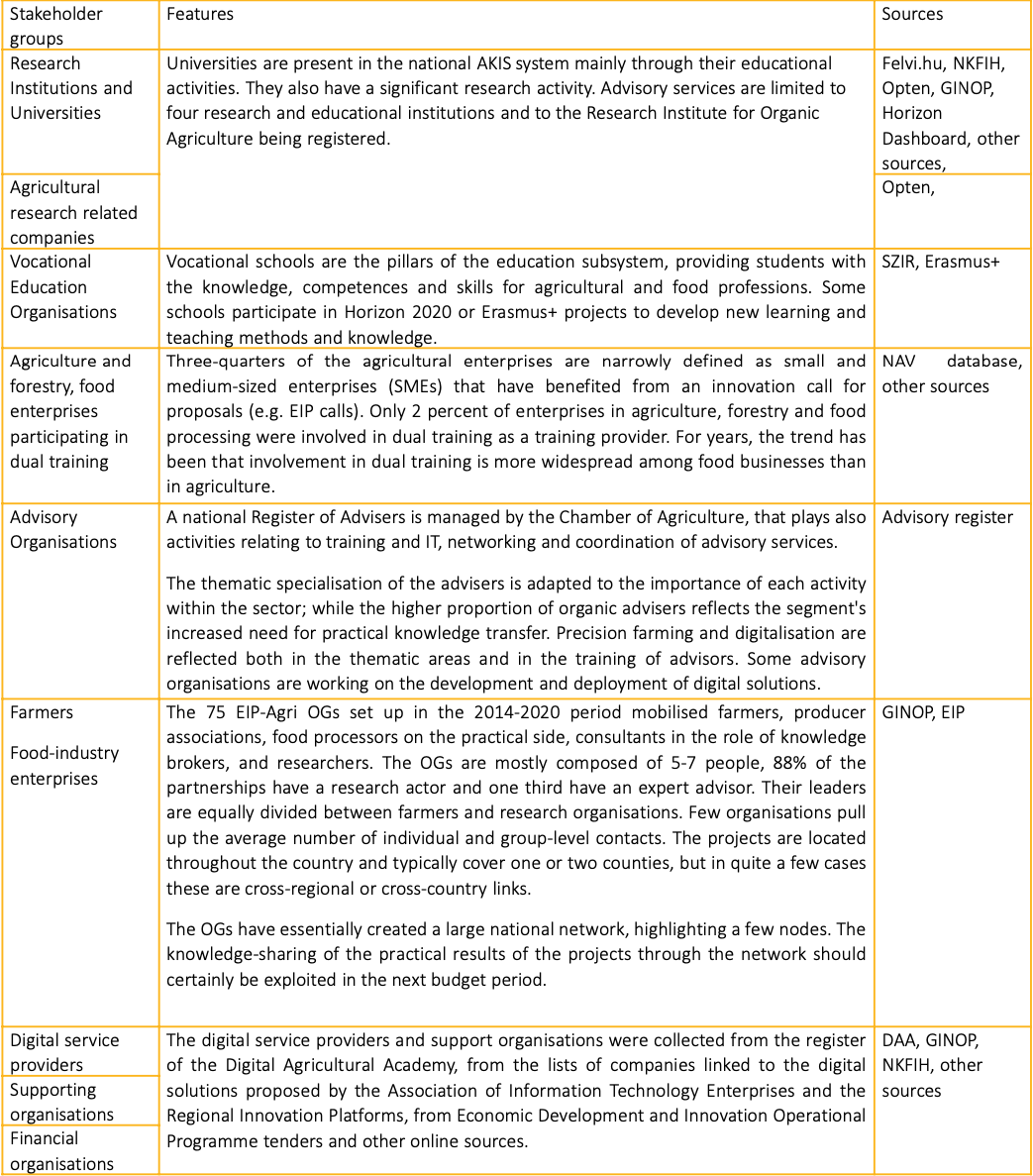2023
CAP network

The CAP Strategy identifies the modernisation of the agri-food sectors as a horizontal objective, through the promotion of knowledge creation and sharing, as well as innovation and digitalisation in agricultural and rural areas. Since 2023, EU Member States are setting up the CAP Networks to promote the CAP Strategic Plans implementation, foster innovation and digitalisation in agriculture and rural development and ensure adequate knowledge flow between different actors.
In Hungary, the CAP Network is linked to the whole of the AKIS, and it aims at bridging the gap between farmers, advisors and researchers, through facilitating the interaction between these different AKIS actors and knowledge flows, along with creating synergies between the actors and the between knowledge transfer, innovation and digitalisation interventions.
In fact, the AKIS strategy of Hungary relies on a farmer at the centre approach that calls for organizing the AKIS in such a way that the different elements of the system work in synergy, with a particular focus on reducing the gap between farmers and researchers, and on integrating technological advances in innovation and digitisation into farmers' practices.
The CAP network will run specific innovation-oriented networking activities that involve and facilitate interaction between all stakeholders to increase knowledge flow within AKIS and to stimulate the creation of EIP operational groups and participation in international knowledge flows such as Horizon Europe (projects, missions and partnerships) and international EIP-AGRI activities.
As well, the CAP Network will create synergies between the CAP and Horizon Europe through the definition of a formal agreement with Horizon Europe, the National Contact Point for Partnerships and the Soil Mission, the National Agency for Research, Development and Innovation and the Express Innovation Agency. This cooperation will be the basis for developing synergies.
The CAP network is set up around three units that support the implementation of the CAP SP on three complex and priority areas (box 1 ).
The CAP Network's was set up in 2022 under the responsibility of the managing authority of the CAP Strategic Plan. It is funded by the Technical Assistance of CAP SP for a total amount of EUR 224.657.534 EUR and over a seven-year plan which is applied by annual work plans.
The setting up of an effective CAP network implies the clear and comprehensive identification of the plurality of AKIS actors to engage in networking activities.
Box 1: Organization of the CAP Network
The CAP Network is organized around three support units:
Innovation and Digitalisation Support Unit.
The main tasks regard the support the EIP and digital switchover interventions of the CAP Strategic Plan, the implementation of the Digital Agricultural Strategy (DAS) and the Digital Food Industry Strategiy and to facilitate the networking of actors involved in research, innovation and digitalisation, and to maintain the database of the green monitoring network to support the implementation of the DAS.Rural and Regional Development Support Unit
The main tasks regard the support for the implementation of the LEADER and other rural development interventions of the CAP Strategic Plan, the Smart Village and Generation Renewal programmes, and to facilitate the networking of rural actors. This unit is run by the Hungarian National Rural Network already in place for the CAP programming period 2014-2022.Green support unit
The main tasks regard the support for the implementation of the green interventions of Pillars I and II of the CAP Strategic Plan and the related national programmes, and to facilitate the networking of green actors. The support addresses the fragmentation of the institutional structure of its domestic climate change monitoring system, including the creation of a good database, for example to consolidate environmental knowledge bases.Source: CAP Strategic plan 2023-2027
In Hungary, a preliminary stage for identifying relevant stakeholders to engage in CAP network’s activities 2023-2027 was the mapping and assessing the current state of play of the Hungarian agricultural innovation and digitalisation ecosystem. This included the following information: i) identification of the organisations of the AKIS and of their activities; ii) identifying the intersections between AKIS sub-networks (advisory, education, research, other); defining the nodes of the national AKIS. The whole activity relied on the collection and analysis of secondary data. Particularly, a national survey was conducted by AKI (box 2) that had been delegated to set up the national CAP network 2023-2027.
The step-wise methodology was applied as it follows:
Box 2: AKI - Agrárközgazdasági Intézet Nonprofit KftAKI is a Research Institute founded in 1954 and owned by the Ministry of Agriculture based on a state act.
The Institute has been Hungary's most significant agribusiness database and policy experience for many decades, performing public and state tasks. One of the most important tasks of the Institute is to develop proposals for the decision-makers of Hungarian agricultural and rural policy, to base the proposals with research based on modern methods, with particular regard to the application and implementation of the Common Agricultural Policy of the European Union in Hungary.
As a flagship of domestic agriculturaligitalization, our institute operates and develops major EU and national information systems such as the test business information network, the market price information system and the agricultural information system. With our extensive data collection, data processing and information organization work, as well as our policy analysis and decision support activities, we help the success of Hungarian agriculture and rural areas.
Our aim is to continue to create a sufficient harmony between professional knowledge, domestic and international scientific research and policy decision support. Continuous contact with professional organizations and active professional involvement are integrated into our daily operations. In order to maintain a close relationship with the agricultural society, information and research results are published in a clear form and time.
Source: CAP Strategic plan 2023-202
Table 1: Stakeholder groups, features and sources of their identification

Source: prepared at the Sustainability Research Directorate of the AKI
In order to replicate the system adopted in Hungary:
https://www.youtube.com/playlist?list=PLMSSGZC_T3nc3PJCkzwneCo1-qYu8P0v5